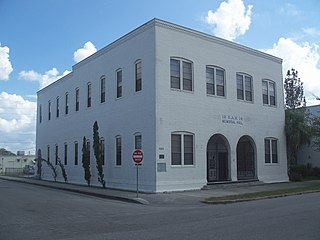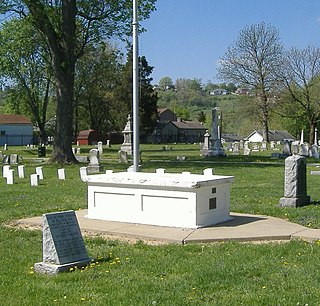Architecture
The building is an example of Neoclassicial, Classical Revival, and Beaux-Arts architecture styles. [2] [5]
The first floor has 2,956 sq ft (274.6 m2) and the basement has 2,702 sq ft (251.0 m2). [10]
"Greenhut Memorial" was carved into the stone facade by Peoria sculptor Joseph Petarde. [11] Corinthian columns, arched windows, and limestone eagles adorn the exterior. [4] There are six stained glass windows, including one that showcases the GAR emblem. [8] [11] [4] The GAR slogan (“Fraternity, Charity and Loyalty”) is inscribed in the main ballroom. [5] A Civil War mortar from 1862 and a pyramid of cannonballs are featured outside the building. [5]
Artwork housed at the GAR Hall include: portraits of Greenhut and his wife, marble bust of General John Logan by Peoria sculptor Fritz Triebel, and other Civil War exhibits. [11] [5]

The Chicago Cultural Center, opened in 1897, is a Chicago Landmark building operated by Chicago's Department of Cultural Affairs and Special Events. The Cultural Center houses the city's official reception venue, where the Mayor of Chicago has welcomed presidents, royalty, diplomats, and community leaders. It is located in the Loop, across Michigan Avenue from Millennium Park.

The Grand Army of the Republic Hall in Litchfield, Minnesota is one of many original and authentic Grand Army of the Republic halls remaining in the United States. Built in 1885 for the Frank Daggett GAR Post No. 35, it is one of four remaining GAR halls in Minnesota. On May 21, 1975, it was added to the National Register of Historic Places.

The Grand Army of the Republic (GAR) Building is a historic building in downtown Detroit, Michigan. It was listed on the National Register of Historic Places in 1986.

The Grand Army of the Republic Memorial Hall is an historic building located at 1101 Massachusetts Avenue in St. Cloud, Florida, in the United States. The city of St. Cloud had been founded by the Grand Army of the Republic or GAR, as a retirement colony for its members. The hall was built in 1914 by members of the GAR as a memorial to the Union Army veterans of the Civil War. It was one of many such halls built in the country. On February 21, 1997, it was added to the U.S. National Register of Historic Places.

The Soldiers and Sailors Memorial Hall and Museum is a National Register of Historic Places landmark that is located in Pittsburgh, Pennsylvania, United States. It is the largest memorial in the United States that is dedicated solely to honoring all branches of military veterans and service personnel.
Grand Army of the Republic Hall, GAR Building, or variants thereof, may refer to:

The Grand Army of the Republic Hall is an historic building located at 34 School Street in Rockland, Massachusetts, in the United States. The hall was designed by local builder William Harrison Hebberd, andbuilt in 1899 by members of the GAR as a memorial to the Union Army veterans of the Civil War. It is a somewhat plainly decorated two-story wood-frame building with a hip roof. Its most elaborate exterior feature is the main entry, a porch supported by clusters of narrow columns, and with brackets in its eaves. The interior is more elaborately decorated, and has retained most of its original Queen Anne details.

The Grand Army of the Republic Memorial Hall, also known as William Baumer Post No. 24, Grand Army of the Republic (GAR), and the Civil War Veterans Museum, is a historic building located at 908 1st Corso in Nebraska City, Nebraska, in the United States. The hall was built in 1894–95. In 1994, it was added to the U.S. National Register of Historic Places.

The Grand Army of the Republic Hall, also known as the General Frederick W. Lander Post No. 5, Grand Army of the Republic, is an historic building located at 58 Andrew Street in Lynn, Massachusetts, in the United States.

The Grand Army of the Republic Hall is an historic building located at 23 East Downer Place on Stolp Island in Aurora, Illinois, in the United States.

The Grand Army of the Republic Monument, in the Linden Grove Cemetery of Covington, Kentucky, was built in 1929 by the O. P. Sine of Garfield Post No. 2 of the Grand Army of the Republic, a group comprising the remaining veterans of the Union army.

The Franklin County G. A. R. Soldiers' Memorial Hall, also known simply as the Soldiers' Memorial Hall, is a historic building located in Hampton, Iowa, United States. The octagonal-style structure was designed and built in 1890 by Edward Carl Keifer. It was the meeting place of the J.W. McKenzie Post No. 81, Grand Army of the Republic (G.A.R.), which was one of 519 GAR posts in Iowa. The building is architecturally significant as it is one of the few examples of a Gothic Revival style structure of this type in the area. It is a memorial chapel that follows a cross-shaped plan capped by an octagonal cupola with a statue of a Union soldier on top. Its significance is also derived from it being the first G.A.R. Memorial Hall built in Iowa. The Iowa legislature had passed a law in 1884 that allowed counties to levy a tax to support building G.A.R. memorials. Captain Rufus S. Benson, a local state representative, had the law amended in 1886 so that it allowed for the construction of a memorial hall, as the local G.A.R. chapter wanted it to be a place where they could meet.

The Porter County Memorial Hall, also known as Memorial Opera House, is an historic Grand Army of the Republic memorial hall located in Valparaiso, Indiana. It was the meeting place of Chaplain Brown GAR Post No. 106, one of 592 GAR posts in Indiana. Designed in 1892 by a local architect, Charles F. Lembke., using Romanesque styling, it was built in 1892–3 to seat 100 people. It was also used as the local opera house.

The Stephenson Grand Army of the Republic Memorial, also known as Dr. Benjamin F. Stephenson, is a public artwork in Washington, D.C. honoring Dr. Benjamin F. Stephenson, founder of the Grand Army of the Republic, a fraternal organization for Union veterans. The memorial is sited at Indiana Plaza, located at the intersection of 7th Street, Indiana Avenue, and Pennsylvania Avenue NW in the Penn Quarter neighborhood. The bronze figures were sculpted by J. Massey Rhind, a prominent 20th-century artist. Attendees at the 1909 dedication ceremony included President William Howard Taft, Senator William Warner, and hundreds of Union veterans.

Hewitt & Emerson was an architectural firm based in Peoria, Illinois. It was founded in 1909 as the partnership of architects Herbert E. Hewitt and Frank N. Emerson. After 1927 it was known successively as Hewitt, Emerson & Gregg; Emerson, Gregg & Briggs and Gregg & Briggs. It was active until at least the 1960s.

The Grand Army of the Republic Memorial Hall, built in 1892, is an historic building located at 401 Railroad Street in Ironton, Ohio. Designed by noted Ohio architect Joseph W. Yost in the Richardsonian Romanesque style of architecture, it was built to serve as a Grand Army of the Republic memorial and the meeting hall of Dick Lambert Post No. 165 of the GAR. It later served as the meeting hall of the now long-defunct American Legion Post No. 59 as well as the Ironton city hall. After being abandoned by the city, American Legion Post No. 433 undertook the task of restoring the long neglected veteran's memorial. On September 19, 2012, the building was added to the National Register of Historic Places. On May 28, 2014, demolition of the building began.

The Black Hawk County Soldiers Memorial Hall, also known as Veterans Memorial Hall, is a Classical Revival veterans hall located at 1915 Courbat Ct. in downtown Waterloo, Black Hawk County, Iowa. It was built starting in June 1915 and first meeting was held there in December of the same year by the Grand Army of the Republic as a memorial to soldiers who died in the American Civil War. It was listed on the National Register of Historic Places in 1988 due to its architecture and importance in local history.

Joseph Benedict Greenhut was an Austrian-born Jewish-American soldier and merchant.


















